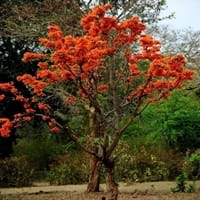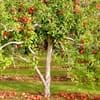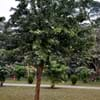Life Span
Perennial
Perennial
Type
Flowering Plants, Fruits, Trees
Tree
Origin
Central Asia
Southern Asia, India
Types
Aceymac apple, Bailey Sweet apple, Dabinett apple, Nehou apple
Not Available
Number of Varieties
Not Available
Habitat
Hillside
Subtropical climates, Tropical Climate
USDA Hardiness Zone
5-8
10-13
Sunset Zone
A1, A2, A3, 8, 9, 10, 11, 12, 13, 14, 15, 16, 17, 18, 19, 20, 21, 22, 23, 24
H1, H2, 23, 24
Habit
Oval or Rounded
Upright/Erect
Flower Color
White
Orange, Black
Flower Color Modifier
Not Available
Bicolor
Fruit Color
Green, Red
Bronze, Sandy Brown
Leaf Color in Spring
Dark Green
Green
Leaf Color in Summer
Green
Dark Green
Leaf Color in Fall
Brown, Green, Light Yellow
Dark Green
Leaf Color in Winter
Not Available
Not Available
Leaf Shape
Oblong
Pinnate
Plant Season
Spring
Spring, Winter
Sunlight
Full Sun, Partial shade
Full Sun, Partial Sun
Growth Rate
Medium
Medium
Type of Soil
Loamy
Loam, Sand
The pH of Soil
Neutral
Acidic, Neutral
Soil Drainage
Well drained
Well drained
Bloom Time
Fall, Summer
Early Spring, Late Winter
Tolerances
Drought
Drought
Where to Plant?
Ground
Ground
How to Plant?
Grafting, Seedlings, Transplanting
Seedlings
Plant Maintenance
Medium
Medium
Watering Requirements
Medium
Average Water Needs
In Summer
Lots of watering
Lots of watering
In Spring
Moderate
Moderate
In Winter
Average Water
Average Water
Soil pH
Neutral
Acidic, Neutral
Soil Type
Loamy
Loam, Sand
Soil Drainage Capacity
Well drained
Well drained
Sun Exposure
Full Sun, Partial shade
Full Sun, Partial Sun
Pruning
Prune when plant is dormant, Remove dead or diseased plant parts
Remove damaged leaves, Remove dead branches, Remove dead leaves
Fertilizers
All-Purpose Liquid Fertilizer
All-Purpose Liquid Fertilizer
Pests and Diseases
Aphids, Canker, Caterpillars, Powdery mildew, Root rot
Rats
Plant Tolerance
Drought
Drought
Flower Petal Number
Single
Single
Foliage Texture
Medium
Medium
Foliage Sheen
Matte
Matte
Attracts
Birds
Birds, Hummingbirds
Allergy
Mouth itching, Throat itching
Anaemia, Kidney Disease
Aesthetic Uses
Not Available
Not Available
Beauty Benefits
Not Available
Not Available
Environmental Uses
Air purification
Air purification
Medicinal Uses
Cancer, constipation, Diabetes, Diarrhea, Dysentry, Fever, Heart problems, Tooth ache
Analgesic, anti-inflammatory, antimicrobial, Astringent, Diuretic
Part of Plant Used
Fruits
Flowers, Gum, Leaves
Other Uses
Used As Food, Wood is used for making furniture
Used as a dyeing color for fabric, used for making charcoal, Used to make leather, Used to prepare a traditional Holi colour
Used As Indoor Plant
No
No
Used As Outdoor Plant
Yes
Yes
Garden Design
Fruit / Fruit Tree, Shade Trees, Showy Tree
Feature Plant, Shade Trees, Tropical
Botanical Name
Malus domestica
BUTEA monosperma
Common Name
Apple Tree
Flame-of-the-forest, Parrot Tree
In Hindi
सेब का वृक्ष
पलाश
In German
Apfelbaum
Flamme -of -the- Wald
In French
Pommier
Flame -of-the -forest
In Spanish
Manzano
Llama - de - la - bosque
In Greek
μηλιά
Φλόγα - of-the - δάσος
In Portuguese
Macieira
Chama -of-the -forest
In Polish
jabłoń
Płomień -of -the- las
In Latin
Arbore
Flamma -of - Silva
Phylum
Magnoliophyta
Magnoliophyta
Class
Magnoliopsida
Magnoliopsida
Clade
Angiosperms, Eudicots, Rosids
Angiosperms, Eudicots, Rosids
Tribe
Not Available
Phaseoleae
Subfamily
Not Available
Faboideae
Number of Species
Not Available
Not Available
Difference Between Apple Tree and Flame-of-the-forest
If you are confused whether Apple Tree or Flame-of-the-forest are same, here are some features about those plants to help you choose better. Many people think that these two plants have the same characteristics, but one can see Apple Tree and Flame-of-the-forest Information and learn more about it. Fertilizers required for proper growth of Apple Tree are All-Purpose Liquid Fertilizer, whereas for Flame-of-the-forest fertilizers required are All-Purpose Liquid Fertilizer. Hence, one should know the basic difference between Apple Tree and Flame-of-the-forest if you are planning to have them in your garden to enhance its beauty.
<
Flowering PlantsImportance of Apple Tree and Flame-of-the-forest
Want to have the most appropriate plant for your garden? You might want to know the importance of Apple Tree and Flame-of-the-forest. Basically, these two plants vary in many aspects. Compare Apple Tree and Flame-of-the-forest as they differ in many characteristics such as their life, care, benefits, facts, etc. Every gardener must at least have the slightest clue about the plants he wants to plant in his garden. Compare their benefits, which differ in many ways like facts and uses. The medicinal use of Apple Tree is Cancer, constipation, Diabetes, Diarrhea, Dysentry, Fever, Heart problems and Tooth ache whereas of Flame-of-the-forest is Analgesic, anti-inflammatory, antimicrobial, Astringent and Diuretic. Apple Tree has beauty benefits as follows: Not Available while Flame-of-the-forest has beauty benefits as follows: Not Available.
Compare Facts of Apple Tree vs Flame-of-the-forest
How to choose the best garden plant for your garden depending upon its facts? Here garden plant comparison will help you to solve this query. Compare the facts of Apple Tree vs Flame-of-the-forest and know which one to choose. As garden plants have benefits and other uses, allergy is also a major drawback of plants for some people. Allergic reactions of Apple Tree are Mouth itching and Throat itching whereas of Flame-of-the-forest have Anaemia and Kidney Disease respectively. Having a fruit bearing plant in your garden can be a plus point of your garden. Apple Tree has showy fruits and Flame-of-the-forest has no showy fruits. Also Apple Tree is flowering and Flame-of-the-forest is not flowering . You can compare Apple Tree and Flame-of-the-forest facts and facts of other plants too.





